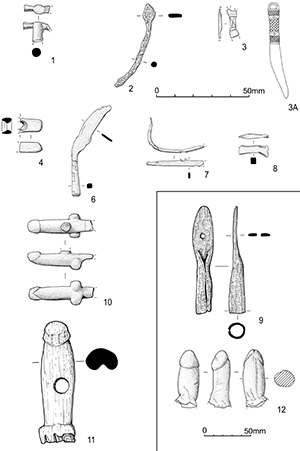
There are few objects of overt religious or amuletic significance from the site, a mere twenty-eight, including all figurine fragments (Table 73). Only four of the objects of overt religious significance are from the area of the temple. There are, in fact, more votives from the area of the settlement than there are from the temple precinct. Nevertheless, Area J (just) has the largest number of votives from a single area, with three from Area H and three from Area M.
The following are copper alloy unless otherwise specified.
Eight model objects are listed below. Some identifications are rather tentative, as the objects are incomplete or damaged.
1. Miniature adze-hammer head. A very well-modelled piece, with the sides of the hammer facetted. The shaft and the blade of the adze were broken in antiquity. The surface is covered in iron products that have preserved the detail (the object was initially though to be iron, as it was magnetic). Vanessa Fell noted that the condition might be due to it having come from a waterlogged context, although it was found in the topsoil. L. 10mm, shaft diam. 5mm. SF2776, Machining layer 4000, Area A, unstratified
2. Iron. Miniature spear. The shaft is bent, and probably had a circular section, now somewhat uncertain due to the effects of corrosion. Complete as buried. L. 48mm. Cleaning layer 5228, Area J, Period 5-6
3. Fragment from a model knife or razor. It has a broken terminal loop, then a raised section with a line at each end, and incised cross-hatching. The blade is asymmetrical, and has a fresh break. The back is flat, with no detail. L. 17mm, max. W. 5mm. SF2255, Cleaning layer 5427, Area I, not dated
The detail on this model is explicit enough to be able to assign it to a knife type; Manning type 7 (Manning 1985a, 111-13). The characteristics of this type (normally made of iron) are a terminal loop, a down-turned blade, and bone plates riveted to a scale tang. The bone handle plates were frequently decorated, most often with bands of transverse lines and cross-hatching (Manning's Q20 provides a good parallel for the Elms Farm model, illustrated here as Figure 560.3a). Manning notes that it is probable that smaller examples of this type were used as razors. Most knives of type 7 are Early Roman, as appears to be the case generally for knives with end loops.
Although model objects, particularly axes and spears, are fairly common finds, model knives are rare. They include possible examples from Chester, with an angled point and a hilt guard (Petch 1975, 35, no. 2), and Gestingthorpe (Henig 1985, 33, no. 75). The latter has a straight back, with a whittle tang with an end loop, and cannot be directly paralleled in Manning's type series. There are two possible model knives from Verulamium. One, from the settlement at King Harry Lane (Stead and Rigby 1989, 25, no. 101), was described as a possible spatula or nail-cleaner; the other (Goodburn 1984, 53, no. 194) is from a mid-1st century context. Both have centrally set tangs and end loops.

4. Small bar fragment, broken across a hole, the edge of which is angled to the centre. Possibly part of a miniature hammer or axe-hammer, although it is not absolutely certain that the butt end of the bar is complete. Miniature hammers or axe-hammers are rare in comparison to miniature axes. Most copper-alloy examples seem to be flat rather than three-dimensional, as this one is. Green (1978) cites an example from Richborough (Bushe-Fox 1949, 146, no. 208) and an unillustrated example in lead from Chester (Green 1978, 54, no. 30). There is also a model iron hammer from Maiden Castle (Wheeler 1943, 286, no. 12) which is three-dimensional, but does not much resemble the Elms Farm fragment. In fair condition. L. 11mm, W. 8mm, hole diam. 4mm. SF5216, Fill 10335, Ditch 10657, Group 838, Area F, Period 5-6
5. Not illustrated. Plate fragment, possibly originally leaf-shaped, but with most of the edge damaged. There is a central rib on one face only, continuing as a 'tang'; the back is flat. Possibly a miniature spearhead. The surface is pockmarked. 18x10mm. SF7210, Machining layer 11000, Area A, unstratified
6. Miniature bladed object, probably a sickle or reaping hook rather than a knife. The handle is a straight, circular-sectioned rod, tapering slightly to the curved 'blade', which has a flat section. Parts of the edge and the tip are missing. L. 52mm. SF7562, Machining layer 17000, Area Q
Most of the objects identified as model sickles have suspension hooks, and could be toilet implements (e.g. from Caister-on-Sea; Darling and Gurney 1993, 130, no. 796), and interpretation suggested for an example from Colchester (Crummy 1983, 61, no. 1939). A closer parallel to the present example is a possible model sickle in lead, from Gestingthorpe (Green 1985, 44, no. 144). Green notes that miniatures of agricultural tools are very rare in Britain.
7. Tapering bent strip, with a probable broken suspension loop on one side. If larger, this would be taken as part of a steelyard, so it is possibly a miniature. However, it cannot be ruled out that this was a functional, though tiny, steelyard, for weighing very small amounts. L. 46mm. SF7813, Cleaning layer 24058, Area M, not dated
8. Fragment, possibly the head from a miniature axe. Bar, widening slightly at one end to a bevelled edge. The other end is broader and flattened, and broken. The identification is somewhat tentative; this is certainly not a standard type of miniature axe. L. 16mm. SF7966, Layer 24221, Group 4027, Area M, Period 4-5
9. Iron. Socketed spear-shaped object with a hole in the middle of the blade. The edges and point are blunt. The socket was formed by folding the sides of the bar to the middle. L. 114mm, socket diam. 18mm, blade W. 23mm. Prepared surface 13045, Group 381, Area H, Period 3 (Figure 560)
This is likely to be a ritual pole tip or votive object. Spear-shaped pole tips have been found at a number of sites (e.g. Baldock; Manning and Scott 1986, 153, no. 523), but generally have two holes at the base of the blade. They have been interpreted as 'rattles'; the example from Baldock still has a ring through one hole. The single, centrally set, hole in the Elms Farm example is perhaps more likely to represent the ritual 'killing' of the object, rather than having been functional. A miniature silver spear from Uley has a similar hole, in addition to having been bent (Henig 1993, 131).
A small lead phallus was also found, but was stolen on site prior to recording. It was seen by the writer, who recalls it as being approximately 40mm in length, without testes, and was probably from machining layer 4000. See Figure 560 for other illustrations.
10. Copper-alloy phallus, modelled in the round, with a rectangular-sectioned bar at the other end. This end is probably broken, and may have an incised transverse line across the top; however, the surface is too poor to be certain. There is a broken circular projection on the top, possibly the base of a suspension loop. This is a fully Romanised form, and, although from a Late Iron Age/transitional context, is unlikely to be pre-Roman. L. 35mm, max. W. 13mm. SF3449, Layer 10293, Group 2099, Area F, Period 2
Greep discusses this class of object as a fertility pendant popular with the military, in relation to two examples from Colchester (in Crummy 1983, 139). The excavations at Lion Walk, Colchester, produced a similar amulet from a deposit dated late 1st to 2nd-century AD, with a second fragment from a mid-1st century pit in Balkerne Lane. The Elms Farm example was recovered from a late 1st to mid-2nd-century pit behind the temple in Area J.
11. A fist-and-phallus amulet with a central perforation (Figure 720). Complete. SF4742, 13388, Pit 18020, Group 3024, Area J, Period 3
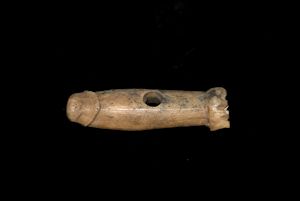
Phalli are not uncommon Roman finds, occurring in relief on Roman pottery, as well as modelled in the round in various materials. For a fuller discussion of the importance of the phallus amulet as a good luck charm, see Johns 1982, 62-3. This ceramic example is well moulded and naturalistic, in a greyish-buff, fine sandy fabric, and has been broken from a larger object, possibly a human figure. This is in contrast to the bone fist-and-phallus amulet from Area J (SF4742), which is complete and has a hole for suspension. The ceramic phallus was found in a late 1st-century AD pit, in Area I, associated with the temple, which suggests that there may be a votive aspect to its deposition. The excavations of the religious site at Ivy Chimneys, Witham produced part of a ceramic phallus of the same size and similar style (Major and Jecock 1999). The occurrence of a similar phallus on another religious site tends to underline the possibility of these finds being votive. While the Elms Farm object came from an Early Roman pit, the Ivy Chimneys phallus was found in a late 4th to early 5th-century feature, but may have been made much earlier.
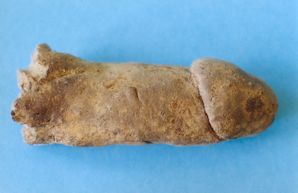
12. A well-modelled, naturalistic ceramic phallus (Figure 140), broken from a larger object. SF6093, Fill 13639, Pit 13640, Group 594, Area I, Period 3A
Cite this as: Henig, M. 2015, Figural bronzes, in M. Atkinson and S.J. Preston Heybridge: A Late Iron Age and Roman Settlement, Excavations at Elms Farm 1993-5, Internet Archaeology 40. http://dx.doi.org/10.11141/ia.40.1.henig1
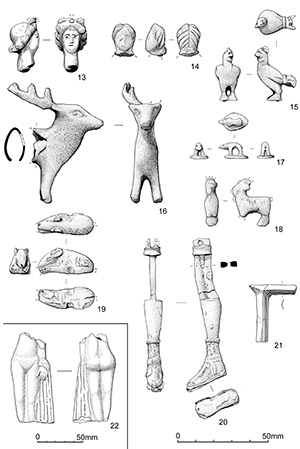
Several items are connected with cult activity. The goat and cockerel are strongly suggestive of Mercury, whose cult animals they were, while the leg too could well appertain to the god of travellers. Votive legs are also recorded at Uley. The other deity attested here is Venus, by two heads from figurines. A votive letter shows that the custom of setting up dedicatory inscriptions was practised.
The little silver boar represents an animal of great significance to the Celts, and although the tiny figurine probably dates to the Roman period, the image, simple as it is, is basically of native type. Together with the stag it would fit with a hunting cult such as that of Diana or, as at Colchester, Temple IV, of Silvanus. The mouse, which has nocturnal associations, and figurines of which are sometimes found in graves, seems amuletic, as is the phallus (no. 10).
13. Female head, with diadem (mainly lost), somewhat stylised facial features which are now rather worn away. The long, elegant neck and the diadem help to identify the subject as Venus. Ht 28mm. Probably Venus or Diana. SF6826, Machining layer 17000, Area Q, unstratified
14. Female head from a figurine. She has a distinctive coiffure of long strands of hair descending from a central parting. Somewhat reminiscent of the head of a Venus figurine from Woodeaton (Pitts 1979, no. 132). There may have been a necklace or torc round the neck, only a small part of which survives. In poor condition. Ht 16mm. SF791, Machining layer 4000, Area A, unstratified
15. Cockerel. The bird is carefully delineated with its head turned to the right; the tail is bifurcated. The legs are shown separately on a small, flat base, but it is probable that this was affixed to a pedestal with a goat or ram and a figure of Mercury, as with the group from King Harry Lane, outside Verulamium (Henig 1984, 60-1, ill. 19). For cockerels from temples of Mercury see Henig 1993, 100-1, fig. 88 no. 4; Bagnall Smith 1999, 31, nos 15-17. SF8427, Context 3999, unstratified
16. Stag. Front part of a hollow cast figurine. Head with one antler with three tines, and two front legs remain. Ht 56mm, surviving L. (snout to end of antler) 58mm. For stag figurines from Britain see Hull 1958, 239, pl. 37c (Colchester, Temple IV); also (with horns separately fitted, now lost), from Richborough see Bushe-Fox 1932, 80 no. 30, pl. xii, and for a much larger and finer example, Henig 1995b, 38, ill. 18 (from Sussex, early post-conquest). Also see Faider-Feytmans 1957, 82, no 46, pl. xxxix (Bavai); Boucher 1976, 222 and pl. 78, no. 380 (Autun). SF811, Machining layer 4000, Area A, unstratified
17. Silver. Minute boar with a rather pointed snout. It has tiny round eyes and a very short tail. It stands on an oval base. L. 13mm, ht including base 10mm. SF961, Machining layer 4000, Area A, unstratified
18. Goat. Very much corroded, horns and front legs missing. L. 20mm, Ht 26mm. For goats from temples of Mercury see Henig 1993, 100-1, fig. 88, no. 3 (Uley) and Bagnall Smith 1999, 31, nos 13 and 14 (Great Walsingham). See also Kozloff 1981, 200, no. 189. The goat was one of Mercury's principal cult animals. SF6365, Machining layer 12000, Area R, unstratified
19. Mouse nibbling fruit(?). The object held between the forepaws has corroded away. No tail preserved. L. 30mm, ht 14mm. cf. RCHM, Eburacum, p. 100 and pl. 34, associated with a burial at York; Allason-Jones 1991, 257, fig. 116 no. 104 (Exeter); other examples Fleischer 1967, 190, no. 275 (from Virunum, Austria); Kaufmann-Heinimann 1994, 64-5 (Kaiseraugst and Winterthur); Kozloff 1981, 185-6, nos 170-172. SF5738, Machining layer 12253, Area B, unstratified
20. Model leg. Total L. 78mm, L. to top of calf 43mm. The foot is shod in a boot with the strapping clearly delineated, terminating above the ankle. Above this is the well-modelled calf. The leg is continued by means of a flat strip containing a piercing, a moulding and above that two thin projections of which one remains, likewise pierced. There is little doubt that this is a votive leg offered and suspended at a shrine to secure healing, or as a thank-offering for it. For a votive foot in a sandal see Faider-Feytmans 1957, 105, no. 245, pl. xl (from Bavai). Note a much less carefully made leg from Uley (Henig 1993, 100-1, fig. 88, no. 8, also nos 7 and 9). SF5806, 11139, Pit 10910, Group 676, Area N, Period 5
21. Votive letter T. The left side of the cross-bar is missing. Ht of letter 32mm. Compare RIB I, 238 (Woodeaton) especially c (T) and 308 (Lydney Park) especially a, l and n. SF2091, Fill 5418, Ditch 5437, Group 422, Area J, Period 4
Cite this as: Wallace, C. 2015, Pipeclay figurines, in M. Atkinson and S.J. Preston Heybridge: A Late Iron Age and Roman Settlement, Excavations at Elms Farm 1993-5, Internet Archaeology 40. http://dx.doi.org/10.11141/ia.40.1.wallace
Of all the Central Gaulish ceramic imports, pipeclay figurines (see Figure 561) are the least common on this site (and in Britain as a whole, when compared with the Gaulish provinces). The excavations produced three fragments from the two most common types, the Venus and the seated Mother-Goddess. There were no examples here of figurines of Rhine-Mosel manufacture, known from other East Coast sites, even though Trier fine dark colour-coat was as common at Elms Farm as similar Central Gaulish ware.
Single examples of the Venus figurine are common enough on Romano-British sites, but by contrast archaeologists on the continent tend to find several of them (or other sorts of figurines) together (e.g. Fauduet 1993, 126-7). We also do not find nearly so many of them associated with temples, shrines and graves in Britain as they do abroad (the only other contexted finds to compare with no. 22 are those from the temple sites at Hockwold cum Wilton, Springhead and Godmanchester; Jenkins (1959, 34-35) lists some other possibles) - all of which may mean that these little objects were less important to the Romano-British worshipper than to their continental cousins. What we do know is that the pantheon of gods and goddesses depicted in pipeclay is just different enough from that chosen by the makers of metal statuettes for us to think of the pipeclay figurines as evidence for the still-strong Celtic part of Romano-Celtic religious beliefs (cf. Vertet 1984)
22. Incomplete Central Gaulish pipeclay Venus figurine (Venus Anadyomene). The figurine lacks its head and shoulders, and its feet and base, but as its costume is wrapped around its wrist it can be seen to be an example of Rouvier-Jeanlin's Type I (Rouvier-Jeanlin 1972, 45: cf. nos 4 and 30) rather than the more common Romano-British site-find, her Type II (e.g. that from adjacent to a possible temple site at Godmanchester: Green 1986, fig. 12.16). These figurines would seen to be current chiefly in the 2nd century in this country. SF4717, Fill 13291, Pit 13366, Group 409, Area J, Period 3
23. Not illustrated. Back of the head of a Central Gaulish pipeclay figurine. From the arrangement of the hair ('la coiffure à bandeaux', or chignon), this piece is from a Venus figurine like no. 22 (compare with catalogue nos 43, 79, 203 and 204, illustrated in Rouvier-Jeanlin 1972). SF3416, Cleaning layer 6609, Area H, not phased
24. Not illustrated. Fragment of the rear half of a Central Gaulish pipeclay figurine. It shows the top of the high-backed wickerwork chair and the back of the neck of a Mother-Goddess-enthroned-with-infants figurine (aka Dea Nutrix: compare with, for example, catalogue no. 380 illustrated in Rouvier-Jeanlin 1972). Detailed classification of this type depends on the details of the front half. SF8420, Cleaning layer 24015, Area M, not phased

25. Small, curved wing. The feathers are suggested by a combination of overlapping arcs and incised herringbone lines. The decoration may have worn away in places. The back is plain. In good condition. As with a wing from Uley (Henig 1993, 100, no. 1) this may have been part of a figurine of Cupid or Victory, and may have been deliberately broken off to serve as an ex voto. SF2504, Machining layer 4000, Area A, unstratified
26. Bell, incomplete and damaged. Hemispherical, with a quadrangular loop, and two incised lines round the middle. The clapper is missing. This rather delicate bell was probably used for religious ceremonies in the temple, as is suggested for the bells from the shrine at Coventina's Well (Allason-Jones and McKay 1985, 28). The surface is silvery coloured; Margaret Brooks suggests this indicates that it has been subjected to heat. Diam. 24mm, Ht 29mm. SF4761, Cleaning layer 5601, Area I, not dated
27. Sheet fitting in two joining pieces. It is now L-shaped, with the longer arm complete, and only one original edge of the shorter arm surviving. The long arm is perforated at the end, and it is broken across a second perforation at the angle. It is possibly a letter L or T, either a votive or from an inscription. In fairly good condition. L. 64mm, W. of complete arm 13mm. SF2347, Fill 6281, Well 6280, Group 531, Area H, Period 3-4
28. Sheet plaque fragment with moulded decoration, one side broken. It has a beaded border round a nude female figure with her left arm raised, with the letters AV.. adjacent to the broken edge, at right angles to the border. There are traces of a third letter, possibly E. There is a broken projection on the back. Possibly Venus. Ht 23mm, surviving W. 13mm. SF4940, Fill 9465, Pit 9464, Group 805, Area D, Period 4
The deposition of artefacts in features such as graves is itself the product of religious acts or motivations that therefore confers a religious, or at least superstitious, significance/function upon the objects themselves. As such, artefacts specifically selected for inclusion in, and deriving from, funerary contexts, are collated by feature assemblage, below. At Elms Farm, funerary features comprise pyre sites, pyre-related features and cremation burials themselves. The reported assemblages do not, however, include any miscellaneous materials often present in small quantities in all types of funerary feature. The cremated bone, present in almost all of these funerary features, forms the subject of a separate report that includes the catalogue, and thus information regarding bone quantities has not been repeated here. The only inhumation, later or sub-Roman grave 10776, did not contain any associated objects.
These assemblages are the product of highly selective depositional acts that span the funerary process; from placement and consumption on the pyre, to burial of significant and symbolic remains and controlled disposal of the remaining detritus (itself likely retaining much significance). As such, consideration of the type, nature and treatment of these objects is crucial to the understanding of Late Iron Age and Roman funerary processes. Further description of the relevant contexts can be found in the site narrative (Section 2), while more developed discussion of funerary features is included in Chapter 7 of the synthetic Volume 1 (Atkinson and Preston 2015). The feature assemblages are listed first, followed by more detailed description and discussion of the relevant artefact assemblages by type.
While there may be differences between Late Iron Age and Roman funerary practices, a thread of continuity connects both periods; the dominance of cremation and subsequent burial of the cremated remains in ceramic vessels as a method of disposing of the dead. With just two cremation burials dated to the Late Iron Age, study of the Late Iron Age ceramic evidence inevitably focuses on the cremation process itself and the subsequent treatment of pyre material, found in more than thirty features. Equivalent evidence dating to the Roman period was not recovered, and the study of the pottery in this period is biased towards the formal burial of the cremated remains, usually in an urn with accompanying vessels, occasionally with a range of other artefacts. Differences extend to the selection of this pottery, typified by the inclusion of fragments, mainly burnt, in Late Iron Age pyre deposits, and the seemingly standard suites of complete, unburnt, vessels in Roman cremation deposits. This is in contrast to the apparently continuing trend of selecting token amounts of human remains for formal burial. Terminology used is that defined by McKinley (1997a).
The pyre sites are all of pre-Roman Late Iron Age date and located in Area W - in the northern hinterland and just outside the perceived settlement area. All of the pyre sites contained varying amounts of incidental material, such as slag, charcoal, burnt flints and baked clay. Fifteen of the twenty pyre sites yielded assemblages of funerary objects; those with no artefacts (2606, 2609, 2672, 2673 and 2705) are not included in this section. The individual feature assemblages are clearly highly fragmentary and incomplete, apparently comprising burnt parts of artefacts that had escaped both contemporary clearance and subsequent cultivation disturbance (historic and modern) due to falling though the pyre and accumulating in below-ground surface ventilation 'flues' during the cremation process. These burnt remains of brooches and ceramic vessels hint at the nature of what are likely to have been more extensive and varied pyre assemblages of personal dress/jewellery items, no doubt worn by the deceased, and of vessels, either containing offerings or being debris of feasting.
Pottery: 27 sherds (206g) coarse ware, burnt, at least four vessels represented

Pottery: 2 sherds (2g) coarse ware, not the same vessel
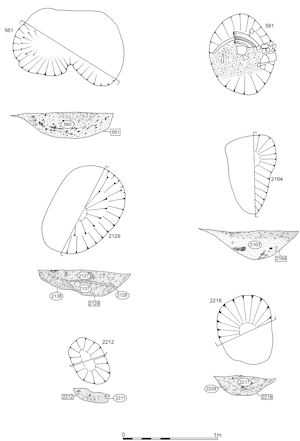
Pottery: 7 sherds (14g) coarse ware, probably all same vessel
Pottery: 5 sherds (4g) coarse ware, burnt and cindery; 26 sherds (42g) Cam 165 flagon, burnt
Glass bead SF238
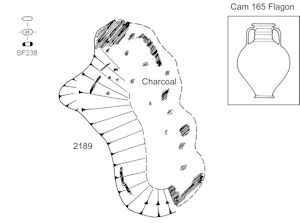
Pottery: 2 sherds (4g) terra nigra, burnt

Pottery: 34 sherds (1510g) Dressel 1 amphora, burnt; 25 sherds (300g) lower half of grog-tempered jar, burnt (not illustrated)
Four (?five) CuA brooches SF56, 96-102, 220, 237
Fe obj. (nail) SF95
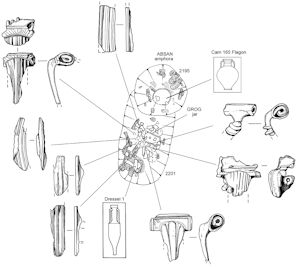
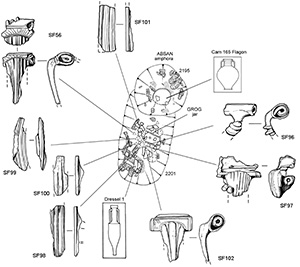
Pottery: 50 sherds (391g) Catalan Dressel 2-4 amphora, burnt and crazed
CuA brooch SF87
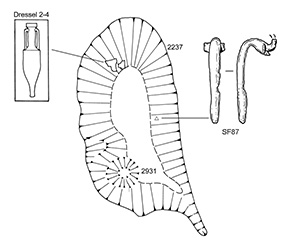
Pottery: 28 sherds (106g) grog-tempered Cam 221 bowl, burnt (not illustrated)
Pottery: 86 sherds (126g) coarse ware, burnt and cindery, possibly all same vessel
Two CuA brooches SF103, 104/117; object SF116
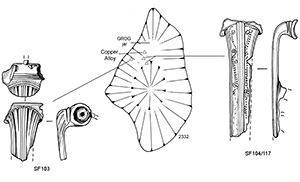
Glass chip
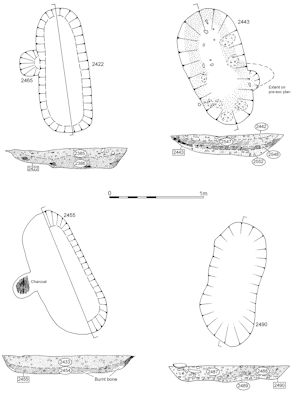
Pottery: 14 sherds (17g) coarse ware, burnt and cindery, not the same vessel
Fe cylindrical socket SF131
Pottery: 26 sherds (228g) coarse ware, burnt, probably all same vessel
Glass fragment
Pottery: 46 sherds (2207g) Dressel 2-4 amphora, burnt; 3 sherds (3g) coarse ware, burnt
CuA brooch SF133
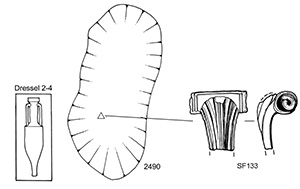
Pottery: 74 sherds (476g) grog-tempered butt beaker, burnt and cindery
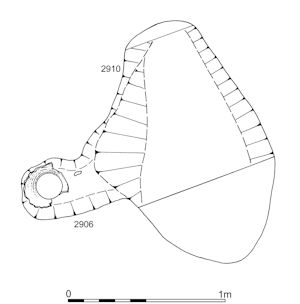

Pottery: 20 sherds (54g) coarse ware, burnt and crazed
CuA objects SF118, 119
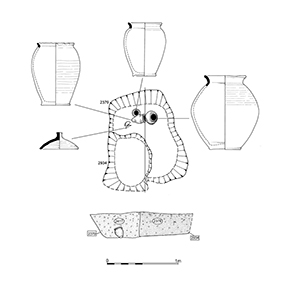
Pits, containing burnt debris presumed to derive from pyres, are largely restricted to the hinterland (Area W) and the relative proximity of the identified pyre site features. The one exception is 15417 in the southern settlement zone (Area M). All are of Late Iron Age date. Eleven pits from a total of fourteen produced related artefacts. Three features (513, 2212 and 2533) that contained no artefacts are excluded from this section. The upper fills of pyre-related pit 15417 contained several items that are unlikely to be part of the primary deposit. These include a part of a puddingstone quern and a loomweight. All have been excluded from the list, although details are held in the archive.
The artefact assemblages from pyre-related pits are not dissimilar to those of the pyre sites, other than displaying greater quantity and diversity of pottery - perhaps reflecting derivation from more artefact-rich surface debris. Like the material from the pyre sites, these shed further light on the composition of the full pyre-good assemblages, with that from pit 15417 strongly indicating the acts of feasting and conspicuous consumption of both foodstuffs and possessions as important aspects of the cremation ritual. The issues of selective collection and deliberate disposal/burial that arise from consideration of the treatment of this material are discussed in Volume 1 (Atkinson and Preston 2015) and below.
Pottery: 3 sherds (8g) coarse ware
Four Fe nails SF225
Pottery: Sherd (4g) coarse ware, burnt
Pottery: 27 sherds (240g) grog-tempered Cam 220 jar, burnt (not illustrated)
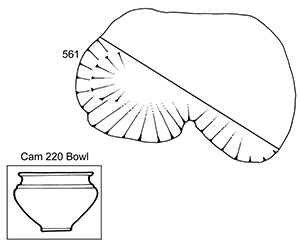
Pottery: 34 sherds (422g) grog-tempered Cam 210 tazza bowl, burnt (Figure 560)
Pottery: 7 sherds (10g) coarse ware, burnt; sherd (2g) South Gaulish samian
Pottery: 15 sherds (168g) grog-tempered jar, burnt (not illustrated)
Pottery: 21 sherds (68g) coarse ware, burnt, not the same vessel
Pottery: Sherd (51g) Dressel 1 or 2-4 amphora, burnt; 102 sherds (364g) lower half of Cam 165 flagon (not illustrated)
Fe nail SF231
Pottery: 47 sherds (120g) grog-tempered jar, burnt (not illustrated)
Pottery: 122 sherds (582g) coarse ware, some burnt, at least four vessels represented; 2 sherds (116g) f31 Central Gaulish samian dish footring base (not illustrated)
CuA brooch SF169
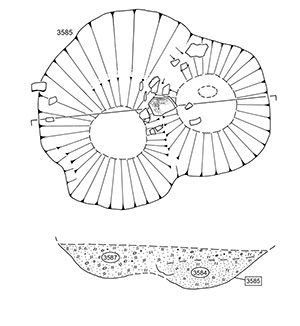

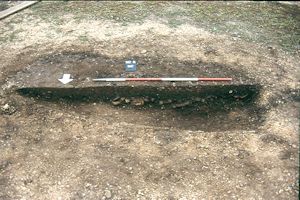
Pottery: 1484 sherds (58469g) various pottery types, at least twenty-five vessels represented, including three amphoras, one bowl, one mortarium, two flagons, five platters, six beakers and seven jars, most burnt (Figure 730)
CuA fragment SF6639
Fe objects SF6649, 7413, 8309
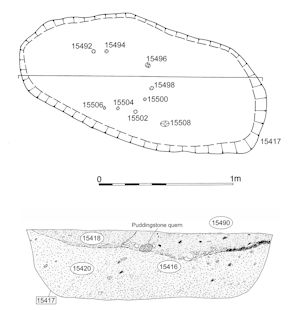
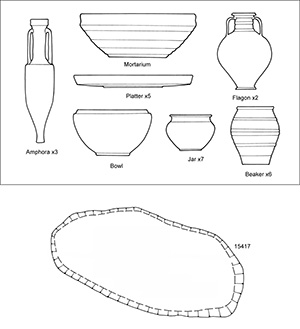
In contrast to the pyre sites and pyre-related pits, the cremation burials are widely spread across the excavated areas. Those of Late Iron Age date occur singly in Areas W and E and small clusters of Roman period graves are located in Areas W, D, M and R, all in peripheral locations relative to occupation areas. Of the twenty-two cremation burials identified, twenty contain artefact assemblages, mainly pottery vessels, related to their function (i.e. objects not incidentally included in backfills, etc.). Cremation burial 559 contained cremated bone only and is omitted from this list. It is notable that Late Iron Age burial 8177 contains burnt remains of an iron brooch-and-chain ensemble. Although significantly more numerous, only two Roman period burials featured obvious pyre goods (bone gaming counters in 12203 and a glass phial in 12219). While these could perhaps have been accidental inclusions, the burnt bone counters indistinguishable from the human remains, it is probably significant that these were two of the most elaborate graves uncovered. Indeed, burial 12203 is a classic example of a 2nd-century well-furnished cremation grave and particularly notable for its box and laden symbolism of the inclusion of both gaming pieces and hanging lamp.
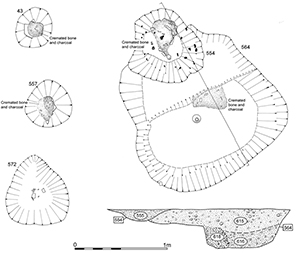
Pottery: lower half of grey ware jar (not illustrated)
Pottery: lower half of grey ware jar (not illustrated)
Pottery: lower half of grey ware jar (not illustrated)
Fe hobnail SF227
Pottery: fine grey ware flask
Nine Fe nails SF88-93, 111-13
Pottery: lower half of black-surfaced ware jar (not illustrated)
Two Fe nails SF228
Pottery: three grog-tempered jars, grog-tempered lid

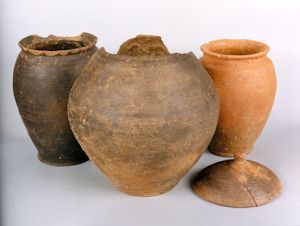
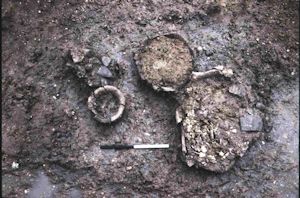
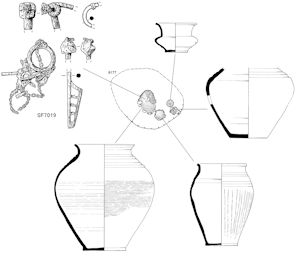
Pottery: three grog-tempered jars, grog-tempered bowl
Fe brooch-and-chain ensemble SF7019
Pottery: 12 sherds (94g) various fabrics (not illustrated)
Pottery: grey ware jar, rimless, H1 beaker (not illustrated)
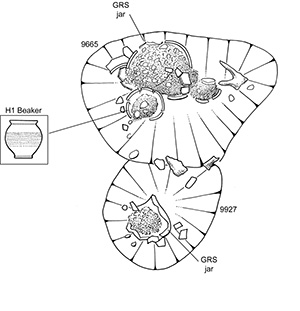
Pottery: grey ware jar, rimless (not illustrated)
Pottery: grey ware jar, black-surfaced ware beaker, both rimless (not illustrated)
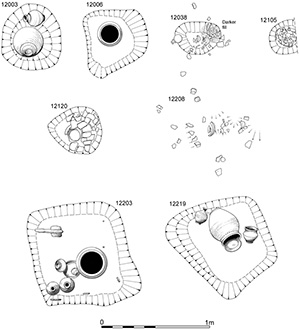
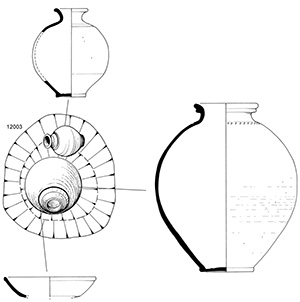
Pottery: G36 grey ware jar, grey ware flask, f31 Central Gaulish samian dish
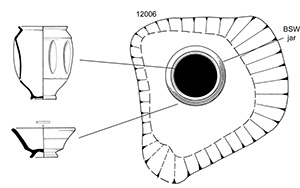
Pottery: black-surfaced ware jar (not illustrated), H20 red ware beaker, f33 Central Gaulish samian cup
Pottery: grey ware jar, rimless, black-surfaced ware flask, burnt (not illustrated)
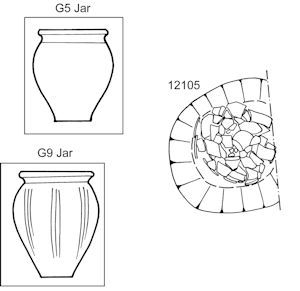
Pottery: G9 black-surfaced ware jar, G5.5 black-surfaced ware jar
Pottery: G5.5 grey ware
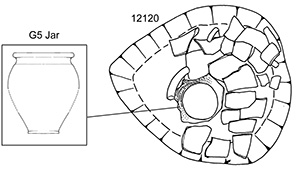
Pottery: G45 grey ware jar, fine grey ware flask, J3.3 Colchester buff ware flagon, H20 Colchester colour-coated ware beaker, f18/31 Central Gaulish samian dish, f33 Central Gaulish samian cup
Fe hanging lamp SF4787, 5744, 6153, 6154
Fe nails SF4785, 4786, 4788
Fourteen+ bone counters SF6566
Glass flask
Glass bead SF7368 (Figure 133 and Figure 736)
See also this file
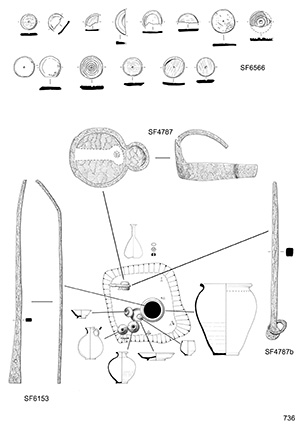
Pottery: G22 black-surfaced ware jar, black-surfaced ware miniature (not illustrated)
Pottery: G45 grey ware jar, fine grey ware flask, G29 black-surfaced ware jar, f18/31 Central Gaulish samian dish
Glass cup
Melted glass vessel
Pottery: lower half of G35-type black-surfaced ware jar, buff ware flagon, rimless
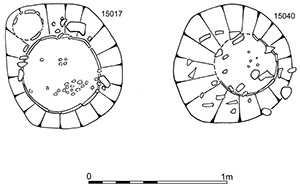
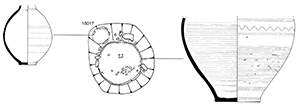
Pottery: G36 black-surfaced ware jar, B1 black-surfaced ware dish, black-surfaced ware miniature
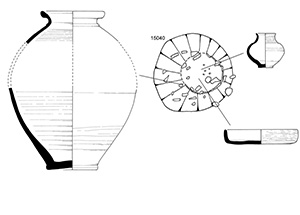
Cite this as: Crummy, N. 2015, The brooches, in M. Atkinson and S.J. Preston Heybridge: A Late Iron Age and Roman Settlement, Excavations at Elms Farm 1993-5, Internet Archaeology 40. http://dx.doi.org/10.11141/ia.40.1.crummy1
One cremation pit of Period 2A, four pyre features of Period 2B, and one cremation pit of Period 3 contained fragments of brooches. Most are of the curved head Langton Down type, the exceptions being two iron brooches of uncertain form, a Simple Gallic (continental Colchester) brooch, and a fragment of a brooch with a debased lion bow, almost certainly of Hattatt's Cravat type (Feugère 1985, Type 18), but possibly a Rosette.
The identifications of the iron brooches from the Period 2A cremation burial 8177 are not certain. Both have multiple-perforated catchplates, and one has the round-section bow, four-coil spring and internal chord common to several types of La Tène III brooches. It may perhaps best be compared to brooch S1 from Phase 1 King Harry Lane (Stead and Rigby 1989, fig. 50). The brooches, and an iron ring with three pierced lugs, had been joined together by a fine iron chain. The number of lugs implies the full ensemble contained three brooches.
Given the lack of a full profile, dating cannot be certain. Brooch-and-ring ensembles were found in cremations in the Westhampnett cemetery, West Sussex (Montague 1997, 97), dated to c. 90-50 BC, while Phase 1 at King Harry Lane is dated AD 1-40 by Stead and Rigby (1989, 84) or perhaps 15 BC-AD 30 as proposed by Mackreth (1994, 288). A date in the first half of the 1st century BC is unlikely for the Elms Farm pair, both of which have multiply-perforated catchplates, but they could conservatively be placed in the second half of the century or the beginning of the 1st century AD.
The main group of brooches from the Period 2B pyre features and the Period 3 cremation pit form a coherent group set firmly in the first half of the 1st century AD, contemporary with the majority of burials in the King Harry Lane cemetery. One pyre feature (2201) contained four (perhaps only three) Langton Down brooches and the probable Cravat brooch, another (2332) two Langton Downs, and a third (2490) a single Langton Down. Period 3 pyre 2908 contained the Simple Gallic brooch. The Period 3 cremation pit (3585) contained one Langton Down. Typologically there is no reason to see this brooch as later than those in Period 2B.
The Langton Down and ?Cravat brooches have been broken across the bow at the weakest point (on Langton Downs above the catchplate), and are represented by either an upper bow and head fragment and/or a lower bow fragment. The consistency of this damage suggests that the brooches have been broken in this way deliberately, not as result of the heat they have undergone on the pyre, which does appear to be the case with the ensemble from burial 8177. In 2201, which contained the greatest number of the brooches, physical force is also suggested by the broken and twisted lion bow (SF96) and by the bent pin and opened and flattened spring-cover of one of the Langton Downs (SF97). The lower part of a Langton Down brooch from a Period 3 pit shows that it too was broken at this point, and it may therefore be related to the cremations (Figure 433, 54).
If these brooches were broken before being placed on the pyre and burnt, then the upper and lower bow fragments of the same brooch might be expected to have undergone differing degrees of heat. They may on the other hand have been broken after they were burnt, when the ashes were picked over to extract material to be buried in the pit. Breakage at this point could be either deliberate or accidental, and missing sections could simply have been overlooked, not diligently searched for (if not all bone was collected (McKinley 1997a, 68), there is no reason to suppose all artefacts were either), or melted completely. In this latter respect it is noticeable that all the catchplates have been reduced to stumps on the back of the bow, and the only pin fragment that remains is that of SF97, where its survival has been aided by the protective cushion of the spring-cover.
In terms of the ritual of burial, it is perhaps more likely that objects were broken after burning, to complete the cycle of destruction that has sent their owner to the next life. In 2201 this is supported by SF56 and SF99, which both have a partly grey and bubbly surface and are assumed to be from the same brooch, and in 2332 by SF104-117, where the punched pattern on the bow allows the equally blackened pieces to be identified as from the same brooch.
The size of the surviving fragments suggests that all the Langton Down brooches were large, and all but one are of the standard form with curved head and reeded bow. Though the lower parts of the bows have been damaged, they probably belong to sub-types Eb at King Harry Lane (Stead and Rigby 1989, 91, 93). The exception (SF104-117 in pyre 2332) also has a curved head, but the bow is divided into two panels by a central ridge, rather than reeded. These panels are decorated with a wavy line and spirals made by round and square punch marks. This decoration is closely matched by that on brooches from Old Sleaford (Mackreth 1997, fig. 86, 11), Fishbourne (Hull 1971, fig. 38, 30), and King Harry Lane, Verulamium (Stead and Rigby 1989, fig. 49, E24).
Of continental origin, Langton Downs are so numerous in Britain that some may have been made here. They date to the first half of the 1st century AD, and in the south-east were popular grave deposits both before, and around the time of, the invasion, for example, in Grave 325 at the Lexden cemetery, dated c. AD 40-5 (Hull 1942, 59-61), and at King Harry Lane in graves of phases 1-3 (Stead and Rigby 1989, 91, 93, 101). They are unlikely to have been deposited any later than AD 50 (see FF1, ).
The type of brooch represented by the debased lion bow is most likely to have been of Hattatt's fantailed Cravat type (1987, fig 17, 780). This is Type XIV at Camulodunum (Hawkes and Hull 1947, pl. XCV, 115). The form is represented at Bagendon (Hull 1961, fig. 32.9), Hod Hill (Brailsford 1962, fig. 8, C 43), Dorchester-on-Thames (Harden 1937, fig. 18, 1), and Silchester (Cotton 1947, fig. 7, 15), where the bow is more obviously leonine. These brooches, like the Langton Downs also deposited in the grave, are continental imports, and Hattatt proposes a manufacturing centre in the Burgundy region. They belong to the first half of the 1st century AD, and are unlikely to survive the conquest by very long.
Simple Gallic brooches came from Phase 1 and 2 cremations at King Harry Lane (Stead and Rigby 1989, 89, B3-B11). The form is continental in origin, but it may be that at least some of those from Britain were manufactured here (Stead and Rigby 1989, 89).

This feature (Period 2B, OA40) contained a brooch with debased lion bow and either three or four Langton Down brooches. The former and three of the latter are represented by their spring-covers and upper bows. Four fairly long and similarly reeded lower bow fragments were also found, all with traces of the catchplate on the reverse, and a few small fragments of a reeded bow also with traces of the catchplate were recovered by sieving. While it might be assumed that each lower bow fragment belongs with one of the upper bows, and the sieved fragments with one of the four larger pieces, this does not appear to be true. It seems most likely that five brooches are represented. The Langton Down upper bows and the lower bow fragments have all clearly been subjected to severe heat, but the lion bow and the sieved fragments are not as noticeably burnt.
SF56 - Copper alloy. Upper part of a burnt reeded bow with the spring-cover. Part of the spring remains. The front of the spring-cover is framed by double grooves, within which are traces of grooves radiating from the head. This is curved and separated from the spring-cover by mouldings. Length 28mm. SF56, Fill 2199(a)
SF99 - Copper alloy. Fragment from the lower part of a burnt reeded bow with a small part of the catchplate. Probably the foot of SF56, above. Length 23mm. SF99, Fill 2199(b)
SF97 - Copper alloy. Upper part of a burnt reeded bow with a crushed spring-cover. Part of the spring remains, and part of what is probably the pin lies across the front of the opened and flattened cover. The head is curved, and may have been separated from the spring-cover by a moulding. Length 25mm. SF97, Fill 2199(c)
SF102 - Copper alloy. Upper part of a burnt reeded bow with the spring-cover. Part of the spring remains. Similar to SF56, with the front of the spring-cover framed by double grooves, radiating grooves within the frame, and a curved head separated from the spring-cover by a moulding. Length 30mm. SF102, Fill 2199(d)
SF98 - Copper alloy. Fragment from the lower part of a burnt reeded bow with a small part of the catchplate. Length 30mm. SF98, Fill 2199(e)
SF100 - Copper alloy. Fragment from the lower part of a burnt reeded bow with traces of the catchplate. Length 28mm. SF100, Fill 2199(f)
SF101 - Copper alloy. Fragment from the lower part of a burnt and twisted reeded bow with possible traces of the catchplate. Length 32mm. SF101, Fill 2199(g)
SF96 - Copper alloy. The upper part of a brooch with lion bow, probably a Cravat brooch, but possibly a Rosette. The spring-cover is plain and part of the spring survives within it. Length 20mm. SF96, Fill 2199(h)
Not illustrated. Copper alloy. Tiny fragments from a reeded foot, thickening on the back to the catchplate. Possibly the foot of SF96. SF237, Fill 2199(i)
Not illustrated. Copper alloy. Tiny fragments, possibly from a brooch. SF220, Fill 2199(j)

SF87 - Copper alloy. Three fragments of a Simple Gallic brooch: part of the pin, part of the spring, and most of the bow with short stumps of small side-wings and the forward hook. The bow is of slightly rounded flat section and turns down sharply below the head. Length 35mm. SF87, Fill 2239, Period 2B, OA40

SF104/117 - Copper alloy. Two Langton Down bow fragments, with part of the spring-cover on one and traces of the catchplate on the other, and two small pieces of the spring. The lower fragment is more heat-darkened than the upper. The head is curved and separated from the spring-cover by a moulding. Between the central and marginal ridges the bow is ornamented with a wavy line and spirals of round and square punch marks. Length (combined) 55mm. SF104/117, Fill 2333(a), Period 2B, OA40
SF103 - Copper alloy. Fragment, not noticeably heat-darkened, consisting of a Langton Down upper bow and part of the spring-cover with some coils from the spring. Three grooves run across the spring-cover close to the head. The moulding between the curved head and spring-cover and the space between the moulding and the triple grooves bear radiating grooves. The bow is reeded. Length 25mm. SF103, Fill 2333(b), Period 2B, OA40

SF133 - Copper alloy. Fragment of a Langton Down consisting of the upper part of a reeded bow and part of the spring-cover in which some of the spring survives. The front of the spring-cover has a frame of double (possibly triple) grooves. The head is curved and separated from the bow by a moulding. The bow is reeded. Length 23mm. SF133, Fill 2487, Period 2B, OA40
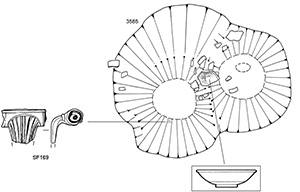
SF169 - Copper alloy. Burnt fragment of the upper bow of a Langton Down brooch with part of the spring-cover and spring. The front of the spring-cover is framed by double grooves. The head is curved and separated by a moulding from the spring-cover. The bow is reeded. Length 20mm. SF169, Fill 3584, Period 2B, OA40

This grave pit (Period 2A, OA12) contained a pair of iron brooches, with a fine chain attached to the one positively identified spring, and in association with an iron ring fitted with three lengths of chain. Both brooches and chain are in fragments, with some pieces still fixed in a lump of burnt and corroded iron and bone. That two brooches are present is shown by two catchplates, one complete (length 45mm) and only the tip of another (length 21mm). Both have ladder-like perforations. The ring was not used to fix the chain to the brooches, but was clearly a separate fitting. It has three small pierced lugs set more or less equidistantly on the circumference, in each of which separate lengths of chain were fixed. These lugs imply that there were originally three brooches in the ensemble. The ring was presumably sewn onto a cloak, allowing the brooches to remain attached when not in use. The cloak may have been worn with the ring on one shoulder, the three brooches set in a line pinning the cloak firmly from the opposite shoulder downwards, with the chains fanning out across the chest.
Pairs of brooches linked together by fine chain came from four graves in the Late Iron Age cemetery at Westhampnett, West Sussex (Montague 1997, 97). In one grave, Grave 20252, where the ensemble was of iron, the chain was attached to the springs of the brooches by large rings (Montague 1997, fig. 82). Rings were also present in two of the other graves, but their relationships to the brooches and chains were not clear.
SF7019 - Pair of iron brooches. The more complete catchplate (c), a bow fragment corroded to it, and the surviving spring fragment all probably come from one brooch (b). The spring is of four coils with an internal chord. A shackle with a fragment of iron chain attached passes through the spring. The stump of the bow visible on this fragment shows it to have been of narrow circular section (length 19mm). The larger catchplate fragment is also from a brooch with round-section bow, as is the fragment corroded onto it. The bow on the smaller catchplate fragment is of narrow rectangular section (a). To it may belong a fragment (j) that may be a much smaller spring with a few links of chain attached (possibly just corroded on), and a curved round-section fragment with what appear to be two mouldings (f). The latter is too narrow and rather too curved to belong to a Knotenfibel, but such an identification cannot be entirely ruled out. SF7019(a-n), Fill 8169
The iron ring is complete (internal diameter 14.5mm) and has three small pierced projections on the outer circumference, to each of which a length of chain is attached (a). The chain links are oval, with a maximum internal diameter of 2mm and 1.5mm thick. The majority of the other fragments are straight or slightly curved circular section shafts, almost certainly from the pins, and lengths of chain.
Cite this as: Major, H. 2015, Metalwork other than brooches, in M. Atkinson and S.J. Preston Heybridge: A Late Iron Age and Roman Settlement, Excavations at Elms Farm 1993-5, Internet Archaeology 40. http://dx.doi.org/10.11141/ia.40.1.major4
Very little other metalwork was recorded and most are fragmentary and unidentifiable pieces recovered from Late Iron Age pyre sites. The iron items from pyre-related feature 15417 are from upper fills and unlikely to belong to the primary burial deposit. The most notable object, however, is the hanging lamp from Early Roman burial 12203, parts of which were found in the pit itself and also inside the urn.
Not illustrated. Small lump of copper alloy; surface poor. c. 11x5x4.5mm. SF116. Fill 2333, Period 2B, OA40
Not illustrated. Iron. Curved plate fragment, probably part of a cylindrical socket. There is mineralised wood on inner surface, but this is not definitely associated with the object. L. 42mm, diam. c. 15mm. SF131. Fill 2548, Period 2B, OA40
Not illustrated. Small copper-alloy rod fragment, surface in poor condition. L. 10mm, Diam. 2.5mm. SF118. Fill 2378, Period 2B, OA40
Not illustrated. Small lump of copper alloy, surface in poor condition. Diam. c. 6mm. SF119. Fill 2378, Period 2A, OA40
Not illustrated. Curved copper-alloy sheet fragment, in very poor condition. c. 13x8mm. SF6639. Fill 15416, Period 2B, OA2
Not illustrated. Iron. Three rod fragments, corroded together. It is unclear whether these were originally a single object. Circular section, Diam. 3mm. L. 39mm, 32mm and 30mm. SF6649. Fill 15490, Period 2A, OA2
Not illustrated. Iron. ?Tool with a two-piece wooden handle with an oval section. It is not clear how the wood is attached, as there are no signs of rivets. The object is a flat bar of constant width, narrowing at the tip to a blunt point. This end may not be complete. The other end is flattened, and probably protrudes beyond the end of the handle. This could be a double-ended tool, with a punch at one end, and a chisel-like blade at the other. In the absence of rivets, the handle may have been held in place by bands of metal, or was possibly bound with twine. L. 176mm, max. W. 17mm. SF7413. Fill 15420, Period 2A, OA2
Not illustrated. Iron. Irregular lump of working waste. c. 30x35x16mm. SF8309. Fill 15420, Period 2A, OA2
Iron hanging lamp. The lamp base is separate from the hanger, which was lying over the base when it was excavated. The base is the normal figure-of-eight shape, with a curved back ending in a circular terminal with a central perforation. The shape of the back is unclear on the X-ray, as the metal is very mineralised, and it was not possible to clarify the shape through cleaning. There may be a hook through the hole, but it is very faint on the X-ray. The back cracked most of the way through in antiquity, and is now distorted.

The hanger is a straight bar with a square section. One end has a blunt point. Unlike most hangers, there appears to be no side spur, though it may have broken off flush with the bar. The other end has a rounded terminal with a penannular ring. Lamp L. 141mm, W. 103mm, depth 28mm: Hanger L. 285mm, W. 10mm, loop external diam. 22mm. SF4787. Fill 12205, Period 3, OA58
The lamp base has an extensive area of mineralised wood on the bottom. The wood displays a butt joint between two planks, which were at least 8mm thick, running down the middle of the lamp. Part of a nail appeared to be present at the joint, but this could be corrosion products from the lamp. The wood was originally assumed to be the base of the box containing the burial, but the sketch with the object implies that the bottom of the lamp lay uppermost, with the hanger at an angle over it. The wood may therefore represent the side of the box. The lamp base may have rested against the side, the lamp having tipped over when the wood rotted, or the wood may have fallen onto the base. The hanger was possibly originally propped in the corner of the box, falling on top of the lamp base after the mineralisation of the wood had taken place.
Hanging lamps are fairly common grave goods. Drury (1978, 99) notes that they occur in relatively well-furnished graves and lists some of those from Essex, including the Bartlow Hills. To these must be added a burial from excavations at Stansted Airport (Havis and Brooks 2004, Cremation burial 25).
Iron. Lamp hanger section. It is in five joining pieces, all but one recently broken. It comprises a bar with a rectangular section. One end is broader, tapering slightly to the main part of the bar. It has a single perforation set centrally, 38mm from the end. The bar becomes thicker at the junction between the terminal and the main bar. The other end is gently curved, and was broken off during antiquity. The very tip is slightly turned up. Found inside the urn. Overall L. 370mm. Terminal L. 59mm, max. section 22x4mm. Bar max. section 15x17mm, min. section 6x4mm. SF5744/6153/6154. Vessel 12197, Period 3, OA58
Not illustrated. Iron. A group of nails from the box, numbering between ten and fourteen. There appear to be two sizes of nail used in the construction; the larger ones have round heads with diameters of 20-23mm, with lengths of about 110mm. The smaller nails have heads with diameters of about 15mm and are about 90mm long. The nails are all straight and may have been used as clamps to hold the planks to the sides of the pit, rather than to join the pieces of wood together. The 'box' may therefore have been a planked pit lining rather than a properly constructed box. SF4785, 4786, 4788. Fill 12205, Period 3, OA58
Cite this as: Compton, J. 2015, Glass, in M. Atkinson and S.J. Preston Heybridge: A Late Iron Age and Roman Settlement, Excavations at Elms Farm 1993-5, Internet Archaeology 40. http://dx.doi.org/10.11141/ia.40.1.compton4
Items of glass were recorded in three Late Iron Age pyre features (2455; 2422/2465; 2189) and two Early Roman cremation burials (12203; 12219). Pyres 2422/2465 and 2455 each contained small featureless fragments of colourless vessel glass and a tiny globular bead was recovered from pyre 2189. The cremation burials each produced more substantial items. Burial 12203 contained a complete, blue-green, funnel-mouthed flask, along with a cylindrical bead. Conical flasks with funnel mouths are rare in burials; ovoid-bodied flasks are more common. A complete colourless cylindrical cup and a melted blue-green unguent bottle were found in burial 12219. Cylindrical cups were the dominant drinking vessel during the late 2nd and early 3rd centuries (Cool and Price 1995, 83).
In his analysis of the glass from the Eastern Cemetery, London, Shepherd (2000, 130) suggested that glass is deposited in graves for two reasons; one, as a significant personal possession, two, as a holder for liquid. Given the relative scarcity of cups in the Roman pottery assemblage, the cup in burial 12219 must fall into the former category. It is also generally thought that deposition of glass vessels in graves, as with samian, indicates relatively high status. Twenty-four glass vessels were recovered from the Eastern Cemetery, against 200 of pottery, providing a ratio of glass to pottery of 1:7. Although there are fewer vessels for comparison, the ratio for the Elms Farm Roman-period burials is 1:13.

Glass bead, complete small globular, dark, appearing black, probably as a result of pyre damage. Diam. 1mm. SF238. Pyre 2189, Period 2B, OA40
Forty joining fragments, almost complete conical-bodied flask. Blue-green. Horizontal out-turned rim, edge partially rounded and rolled in. Funnel mouth. Long cylindrical neck. Straight side, tapering in to simple concave base. Very thin-walled. Many small bubbles, elongated in neck. Rim diam. 36mm, neck diam. 12mm, base diam. 52mm, wall thickness 0.2-1.5mm. Fill 12204, Period 3, OA58 (Figure 736)
Not illustrated. Complete short cylindrical bead. Opaque mid-green. Diam. 4.7mm, perf. diam. 1.1-1.3mm, height 2.5mm. SF7368. Fill 12205, Period 3, OA58

Almost complete, cylindrical wheel-cut cup. Colourless. Small area missing from rim. Slightly out-turned rim, edge cracked off and ground smooth. Cylindrical body, tapering in slightly to small flat base which thickens towards the centre with a small central concavity. Faint horizontal abraded lines below rim, on upper body and above base, and two close-set, broad, wheel-cut lines around the centre of body. Edge of base lightly worn and scratched. Small to large bubbles. Strain cracks. Rim diam. 80mm, base diam. 35mm, height 61.5mm, thickness 1mm. Fill 12214, Period 3-4, OA58
Not illustrated. Melted amorphous mass, blue-green. Precise form not identifiable, but possibly an unguent bottle. Fill 12214, Period 3-4, OA58
The counters were classified according to the Colchester type series (Crummy 1983, 91). It is possible that they represent a complete gaming-set, but the fragmentary nature of some of them suggests that not all have survived the pyre and subsequent burial. Counters of bone and other materials are common finds in burials.
Bone counters, all lathe-turned (Figure 736). Two Crummy Type 2, one complete and one damaged. The upper surface is decorated with four concentric grooves. Twelve Crummy Type 1, six complete and six damaged; four small fragments. All burnt. Found inside the urn among the cremated bone. SF6566, Vessel 12197, Period 3, OA58
The ceramic evidence in Late Iron Age and Roman-period funerary features comprises mainly burnt sherds in pyre sites and pyre-related features, and unburnt intact vessels in graves. Thirty-three pyre features, either pyre sites or related pits, and two cremation burials of Late Iron Age date were identified. Most of the activity was confined to the hinterland (Area W), although a single cremation burial was uncovered in Area E, on the edge of the northern settlement zone. Pottery was included in both burials, but recovered from only twenty-four of the pyre features. In addition, a pyre-related deposit (15416 in pit 15417) comprising a large collection of burnt and heat-shattered pottery was recognised and is described separately below.
A total of twenty cremation burials of Roman date were uncovered. Although no pyre sites, pyre-debris deposits or related features were excavated, the Roman-period cremation burials nevertheless supply sufficient data for meaningful consideration. Albeit thinly distributed in locations peripheral to the main settlement, the burials span the Early Roman period. The group of four burials from Area D is among the earliest, dating to the second half of the 1st century AD. Unfortunately, the small groups from Areas M and W cannot be dated more closely than Early Roman. The largest group, from Area R, dates to the second half of the 2nd century, possibly extending into the 3rd century. All but one burial (559) yielded ceramic vessels that served either as containers for the cremated bone or as ancillary grave goods.
Cite this as: Compton, J. 2015, LIA Pyres and pyre-related features, in M. Atkinson and S.J. Preston Heybridge: A Late Iron Age and Roman Settlement, Excavations at Elms Farm 1993-5, Internet Archaeology 40. http://dx.doi.org/10.11141/ia.40.1.compton5
There are twenty pyre sites and thirteen pyre-related deposits, although there appears to be nothing in the finds that would certainly distinguish either group from the other. In the features containing pottery, only small quantities were found, consisting mainly of burnt sherds and representing a fraction of the vessels originally present on the pyre. The degree of burning varies, from sherds only reddened by heat to those that are cindery and burnt beyond recognition. Variation in burning occurs among sherds found in the same contexts, perhaps indicating the variable temperature at different locations within the pyre. Nonetheless, the remains selected all seem to have been on the pyre. There are six instances where the fragments are identified as unburnt. In four cases, the sherds are too small for comment, having an average sherd weight of less than 2g. The fifth is the footring base from a samian dish, although this is a later (2nd century) vessel and must be intrusive. The sixth example comprises the base and lower body from a Central Gaulish Cam 165 flagon found in pyre-related feature 2195, and perhaps truncated by ploughing. A small portion of the cremated bone (68g) was apparently found inside the vessel, and a larger amount (239g) was beneath the base. Since the cremation pit had been truncated in antiquity, it is unclear whether the bone was within the flagon when it was interred. The flagon is therefore not considered to be either a container or an ancillary vessel, rather it may represent an offering allied to the cremation rite itself. The cut that contained the flagon, along with a single burnt amphora sherd, had been inserted into one end of pyre site 2201, although the flagon was not resting on the floor of the cut. The amphora sherd, from an Italian Dressel 1 or 2-4 wine container in 'black sand' fabric, was from a different vessel from the amphora sherds found in pyre site 2201. This might suggest that the sherd had been deposited at the same time as the cremated bone and the flagon as part of a separate ritual.
The pottery found in the pyre sites is listed in Table 201, and Table 202 lists the pottery from pyre-related features. It can be seen that there are very few differences in the pottery from either feature type. There are marginally more imported wares from the pyre sites, and more of the pyre-related features seem to contain unburnt pottery.
The types of pottery in both pyre sites and pyre-related features form a pattern of sorts. Most of the pottery comprises fragmentary grog-tempered ware, with few definite forms recognised and those identified indicate no preference for vessel type. Imported pottery of Late Iron Age date was recovered from the pyre sites, with the exception of pyre-related feature 2195. The burnt and fragmentary nature of most of the pottery clearly demonstrates that these sherds represent the residue from material burnt on the pyre which, for whatever reason, was not collected from it for incorporation in the burial or for secondary disposal away from the pyre. The few vessel classes identified display much variety; platters, bowls, beakers, flagons, jars and amphoras are all represented, although too fragmentary for quantification. It is probable that many held food and drink as offerings on the pyre, and thus had served their purpose in the ritual. The vessel parts remaining after collapse of the pyre also demonstrate the disparate nature of these deposits. Body sherds form the bulk (48%) of the pottery assemblages, with rim and base sherds each forming just over 20% of the total. Complete profiles were recovered in only two cases, from pyre site 2254 and from pyre-related feature 581. The latter comprises joining rim, body and pedestal sherds from a heavily burnt Cam 210 tazza-bowl (Figure 728), but less than a quarter of the original vessel survives.
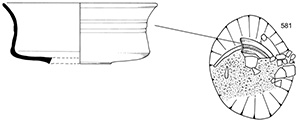
The amphoras found in the pyre features have fractured in a very distinctive way, due to the extreme temperatures involved and the thickness of the vessel walls. These sherds have formed into elongated cubes, where they have split along heat-induced stress-fractures, resulting in a lower average sherd weight than normal (32g compared with 69g for the whole amphora assemblage, and 100g for all amphoras other than those in pyre-related assemblages). Other sherds from pyre features represent much smaller vessel parts, in most cases little more than single, though sometimes large, fragments. This is especially true of lower wall and base sherds, where a larger piece is more likely to survive due to the thicker nature of this part of the vessel. These larger pieces are the exception rather than the rule, and, even so, represent only a small fraction of the original vessel.
Similarities can be inferred from the pottery found in pyre features discovered on the route of the A27 bypass at Westhampnett, West Sussex (Mepham 1997, 137), although no imported pottery was recovered from this site. Sherds found both in pyre sites and in pyre-related features were indistinguishable from each other, and Mepham suggests that some pottery was left at the pyre sites while other sherds from the same vessels were deposited in pyre-related features. Vessels deposited in the main cemetery were whole and unburnt, though there was correlation between the pottery types, both in the cemetery and at the pyre sites. The main difference is in the condition of the two types; that from the pyre features being burnt and fragmentary, suggesting that the rites associated with burial in graves and those associated with the cremation itself were distinct and separate (Mepham 1997, 137). This would also appear to be the case at Heybridge.
Four features contained imported fine ware, including pyre-related feature 2195 which held the flagon base, described above. Sherds from a similar Central Gaulish flagon, this time very burnt, came from pyre site 2189. Two pyre sites, 2196 and 2443, produced tiny sherds of terra nigra, probably from platters. Burnt amphora sherds were recovered from three pyre sites, representing three different vessels; two are Italian, forms Dressel 1 and Dressel 2-4, and the third is a Catalan form Dressel 2-4. These imports provide dating evidence for the pyre features; the amphoras, Cam 165 flagons and terra nigra all probably first arrived at Heybridge during the last quarter of the 1st century BC. All three pottery types can also be found in contexts of early 1st century AD date, although Dressel 1 amphoras would normally be considered to be residual by this time. Central Gaulish flagons ceased to be imported c. AD 20 (Rigby 1989, 120), but terra nigra continued into the mid-1st century AD. Supporting dating evidence is provided by brooch fragments, recovered from five features (see above), three of which also contained amphora sherds. Most of the activity represented by the pyre features can probably be dated to the first half of the 1st century AD, with a start date perhaps late in the previous century. The presence of Roman pottery, including samian, in at least three deposits indicates that activity continued into the mid- to late 1st century.
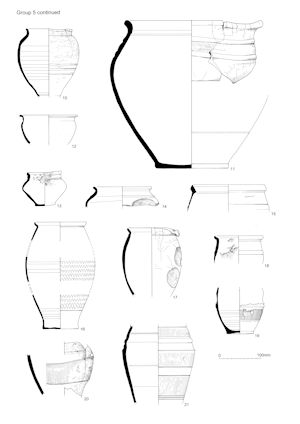
A single feature, pit 15417 (15416), although at some distance away from the pyre features described above, has been interpreted as a large deposit of pyre debris. The importance of the deposit was recognised at an early stage and the pit was fully excavated. The pottery is described in full elsewhere (see Key Pottery Group 5 and Pottery supply). There are sufficient similarities in the probable treatment and in the pottery types with the material in the pyre sites and pyre-related features to support the interpretation as pyre debris. Most of the sherds (92%) are burnt, some to a very high degree, and the average sherd weight is low, indicating that a similar process to that in the pyre features had taken place, although no cremated bone was present. The major difference is in the quantity of pottery in the deposit (58.5kg), in contrast to the low quantities recovered from the pyre features. There are large parts of three Dressel 1 amphoras, again fragmented into cube-shaped sherds, although the average sherd weight for these is higher at 52g. This is probably accounted for in part by the presence of the base and spike from one of the vessels. Also present are large sections from terra rubra platters, Central Gaulish wares and a number of grog-tempered vessels, including jars, beakers and a bowl. The pottery types, and the date of the deposit, are compatible with the pyre features. Despite the degree of burning, large numbers of sherds conjoined, allowing many of the vessels to be reconstructed sufficiently for illustration (Figures 233, 234 and 235). A minimum figure of twenty-five has been calculated, although a small number of sherds (7.3%) could not be assigned and at least some of these might represent single occurrences from further unidentified vessels. Examination of the surviving vessel proportions indicates that, on average, only a third of each vessel represented had been deposited.


The reconstructed assemblage comprises seven jars, six beakers, five platters, three amphoras, two flagons, one mortarium and one large bowl. The vessels originated from a wide geographical area. The Dressel 1 amphoras are probably Campanian, as is a bead-rimmed Pompeian-red ware platter. This platter form appears to be unparalleled in Britain, although a single example with half-round external beading from Camulodunum is cited in the type series (Hawkes and Hull 1947, 221). Central Gaulish imports are represented by a Cam 165 flagon and a Cam 1 platter. Three platters are Gallo-Belgic, probably terra rubra from the Vesle valley near Rheims (S. Willis, pers. comm.), although severe burning has made precise fabric identification difficult. Also severely burnt, was a terra rubra Cam 112 beaker. A second beaker, a large Cam 113, is the only vessel from northern Gaul. The form was a long-lived type, although this example is barrel-shaped, which is an early characteristic (Rigby 1989, 138).
The remaining thirteen vessels are likely to have been locally made and are, in the main, grog-tempered. A single shell-tempered Cam 255 jar probably originated in the Thameside area of south Essex or north Kent. All of the vessels are wheel-thrown, except for a small Cam 259 jar, which is roughly finished and may be hand made. The large bowl is part of a lid-and-bowl set in the style of Cam 253, although no lid was found in the deposit. The bowl rim is certainly recessed to take a lid, which in Cam 253 is high-domed with a hollow knob. This form of lid-and-bowl set is a common find in burials in south-east Britain, with Augusto-Tiberian antecedents found in the Rhineland (Hawkes and Hull 1947, 267). A cremation burial at North Shoebury, Essex, contained a similar bowl, with inturned rim but also without the lid, accompanied by a cordoned Cam 252 lid-and-bowl set (Thompson 1995, fig. 70). This burial is dated late 1st century BC to early 1st century AD. Three of the beakers in the pyre-debris deposit bear zones of combed decoration between cordons, in imitation of rouletted Gaulish beakers; the fourth is plain, except for a cordon under the rim. The jars are also plain, except for one very large example which has incised chevron decoration on the shoulder cordon. The last vessel is a grog-tempered flagon and is probably a local copy of the Central Gaulish Cam 165.
Almost all of the grog-tempered pottery is burnt to a red/orange colour with various cracks, spalls and cindery grey patches, the degree of which perhaps depending on the proximity of the pot to the heat-source. Only one beaker retains its original, reduced finish, although there are several more unburnt sherds that appear to be from further vessels. Much of the imported pottery is also burnt, heat-discoloured, cracked and distorted, and the illustrations (Figure 233, 234 and 235) have been produced to reflect the condition of the pottery. The Pompeian-red ware platter is particularly distorted and discoloured, although the distinctive black sand fabric is still recognisable. The breakage was originally thought to have been deliberate, and to have taken place prior to being subjected to burning. However, reconstruction of the larger grog-tempered vessels has demonstrated that much of the pottery seems to have split along the fissures produced during the height of the burning process. There is no direct evidence to suggest that the grog-tempered vessels were deliberately broken. As noted above, the amphoras also seem to have split into small sherds along heat-fractures, rather than to have suffered deliberate breakage.
The temperature required to produce these effects must have been intense. Sherds of burnt and distorted pottery were recovered from a Late Iron Age ditch at nearby Slough House Farm and are discussed by Horsley and Wallace (1998, 146). The possibility that this deposit may represent pyre waste was not considered but, in describing the temperature necessary to reduce pottery to a cindery state, they suggested that a sustained temperature in excess of 1000°C would be required (following Rye 1981). Horsley and Wallace considered that maintaining such a temperature under open firing conditions would be unusual, but work by McKinley (1997b) suggests otherwise. Experimental pyre cremations were conducted at Guiting Power, Gloucestershire, where recorded temperatures of over 1000°C were maintained for up to three hours (McKinley 1997a, 134). The evidence suggests a pyre-related cause for the condition of the pottery from pyre-debris pit 15417, rather than deliberate manual breakage, followed by burning, as originally posited.
Whereas the majority of the pyre-debris pottery has been burnt, as already noted, a small number of sherds in the deposit are unburnt. There are unburnt fragments from a grog-tempered butt beaker (Figure 234, no. 21), on which the scheme of combed decoration matches that on a severely burnt vessel (Figure 234, no. 20). Although these decorative schemes are not individually distinctive, it is not beyond the bounds of possibility that the burnt and unburnt fragments are from the same butt beaker. Two other burnt vessels certainly have conjoining unburnt sherds; the Cam 165 flagon (Figure 235, no. 22), and the Cam 113 butt beaker (Figure 234, no. 15). The presence and quantity of unburnt sherds might depend on how the vessels were stacked on the pyre. Once the cremation process was fully under way, collapse of the pyre might have resulted in the breakage of vessels, with some sherds perhaps falling away from the heat.
The deposit appears to be a connection between the rituals of cremation and the rituals of burial. Most of the cremated bone had perhaps been collected from the pyre site and interred within whole vessels. Paralleling this, it appears that most of the pyre-debris pottery was given its own 'burial' in a separate ceremony and location. Hence, perhaps, the small quantity and size of the sherds remaining at pyre sites; larger pieces may well have been selected for just such a ceremony. Or the possible reuse of pyre sites might require clearance of pyre debris, still treated with a degree of respect even though not accorded full burial rites along with the cremated remains. The absence of other pyre-goods in this deposit might indicate that only the pottery was accorded this degree of respect. That the pyre-debris deposit was located some distance from the pyre sites may also have been a deliberate act. At Westhampnett, the quantities of pottery found in pyre features were also small, and Mepham suggests (1997, 137) that the rest of each vessel might have been disposed of in ways that precluded recovery during excavation. The possibility seems to be that pyre debris was buried away from pyre sites, making the link between deposits of burnt pottery and funerary activity difficult to establish, particularly in the absence of cremated bone, as in this deposit. The study of pottery treatment may be one of the ways to do this, especially if sherd links can be established. Hints at differences in customs and rituals associated with the cremation rite are also provided by the burial in the Lexden Tumulus (Foster 1986a) and the complex ceremony that seems to have taken place at Folly Lane, Verulamium (Niblett 1999). Further significance of the assemblage from pyre-debris pit 15417 for our understanding of pyre technology, cremation and funerary practices is discussed in Volume 1 (Atkinson and Preston 2015).
The dating of the assemblage is not straightforward. Dressel 1 amphoras have an accepted terminal date for importation of 10 BC. Many of the other imported wares have dates for their initial production that range from 25 BC to 15 BC, and most continued to be imported until at least AD 25. Campanian Pompeian-red ware occurred on continental sites in the Augustan period (Peacock 1977a, 158). These include Oberaden (occupied c. 12-8 BC) and Haltern (occupied c. 9 BC-AD 9), and bead-rimmed Pompeian-red ware platters were found at both, although never common (Loeschcke 1909, 271; taf. xiv, no. 75B). In describing the Pompeian-red ware from Usk, south Wales, Greene (1979, 130) noted that the loss of an external bead on the rim occurred early in the 1st century AD.
The mortarium may be Italian in origin, and a likely arrival with the amphoras (P. Tyers and K. Hartley, pers. comm.). A similar type of mortarium was found in features dated c. 10 BC-AD 20 at Skeleton Green (Partridge 1981, 32), and can also be paralleled at Haltern (Loeschcke 1909, 242, abb. 33). The Italian imports may be the earliest in the assemblage, possibly first arriving at Heybridge at the beginning of the last quarter of the 1st century BC. Importation of Central Gaulish micaceous wares into Britain also probably first occurred c. 25 BC (Rigby 1986b, 270), but ceasing by c. AD 20/5 (Rigby 1989, 120). Production of the Gallo-Belgic platter types found in the deposit probably commenced slightly later, by c. 15BC (Rigby 1989, 121) and had also ceased by c. AD 25.
In contrast, the coarse pottery vessels were very unlikely, on typological grounds, to have been in production as early as 15 BC, and were more probably introduced during the early 1st century AD. The jars, especially, are 1st-century AD types, and their shoulders are plain or cordoned, rather than rippled. Therefore, a date for the deposit at the very end of the 1st century BC, or, more probably, the beginning of the 1st century AD, is proposed, implying that the amphoras, along with the other Italian vessels, are likely to have been old when deposited.
In contrast to the number of pyre features, there are few formal burials of Late Iron Age date, perhaps indicating that cremation may have been a restricted rite and the formal burial of cremated remains was the exception rather than the rule. Although not located in close proximity to each other, the two burials have similarities; Table 203 summarises the pottery types. Both can probably be dated to the last quarter of the 1st century BC, although there are few intrinsic dating factors (see below).
| Feature | Area | Cinerary vessel | Ancillary vessels |
|---|---|---|---|
| 2379 | W | Jar EF170 (GROG) | Jars EF171, EF172 (GROG), lid EF202 (GROG) |
| 8177 | E | Jar EF160 (GROG) | Jar EF159 x 2 (GROG), bowl EF44 (GROG) |
Each cremation burial contained a jar, used as the cinerary urn, and three ancillary vessels. None of the vessels can be closely paralleled in the Camulodunum type series. The cinerary urn in burial 8177 (EF160) equates to Thompson's B2-4 (1982, 133). A similar jar with rippled shoulders came from the New Cemetery at Heybridge in 1912 (Thompson 1982, vol. 3, fig. 44.1100). This vessel contained cremated bone and was found with a cut-down Arretine platter that had been used as a cover for the urn. The platter is included in the gazetteer provided by Wickenden (1986, 53), where the Late Iron Age cremation cemetery is dated late 1st century BC to early 1st century AD.
Three ancillary vessels lay to the east of cinerary urn EF160. These comprise two jars (EF159) with rippled shoulders and a carinated bowl (EF44). One jar, as recovered, is rimless and friable, probably under-fired originally, and is similar in form to the urn (either Thompson's B2-4 or B2-3). The third jar equates to Thompson's B3-6, but has decoration on the lower body comparable to another jar from Heybridge (Thompson 1982, vol. 3, fig. 44.1091). The fourth vessel, a carinated bowl, is unparalleled, but falls into Thompson's Class E1-4, with the addition of a cordon beneath the carination. The E1-4 form was common in the first half of the 1st century AD, but was infrequent at Camulodunum, where the type was conflated with Cam 214 (Thompson 1982, 369).
The cinerary urn from burial 2379 (EF170) is a plain jar with an everted rim and a neck cordon. The form matches Thompson's B1-2, which was long-lived. Three ancillary vessels lay to the west of the urn and comprise two plain jars (EF171, EF172) and a lid (EF202). Jar EF171 equates to Thompson's form B5-2, with the closest parallel at Brickwall Hill, Hertfordshire (Thompson 1982, 647, no. 17). The form is similar to Cam 118, an example of which occurred in the Lexden cemetery, Colchester (Hawkes and Crummy 1995, fig. 7.2). Jar EF172 is a Thompson B4-2 with red surfaces, probably imitating terra rubra. The closest parallel is from Holborough in Kent (Thompson 1982, vol. 3, fig. 48.1031), where a continental influence is suggested. The fourth ancillary vessel is a plain lid, slightly domed with a shallow groove along the edge of the rim and a short, solid knob. Lids are difficult to categorise and were not always made to fit the vessels they accompany, and this example could have covered any of the jars with which it was deposited.
The pottery from each of the Late Iron Age cremation burials differed in the treatment received before or upon deposition. Both burials contained jars, all of which probably had highly burnished surfaces originally. Three of the vessels in burial 8177 had been subjected to partial but severe heating, possibly just prior to deposition. The cinerary urn had been patchily burnt internally and externally, and the exterior of the base was completely reddened indicating that the jar may have been placed on a very hot surface prior to (or upon) burial. Along with the cremated bone, the urn contained fragments of an iron brooch-and-ring ensemble (see above). A large piece of one of the brooches had fused to the inside of the base, probably as a result of the high temperature, but this could equally have occurred after deposition, perhaps due to the percolation of rainwater. Two of the ancillary vessels had also been affected by heat, but the third was probably under-fired and is now in very many fragments, such that any comment is difficult. The carinated bowl had been scorched, mostly on the interior of the rim but also in patches externally, and the cordoned jar is partially burnt on the base and very patchily on the exterior. The vessels all seem to have been placed upright in the grave, although damage was sustained during machining prior to excavation.
The vessels in burial 2379 also seem to have been placed upright, although the lid had probably been displaced and was recovered, in two pieces, from the floor of the grave. Whether this occurred upon, or following, deposition, perhaps when the grave was backfilled, is difficult to ascertain. The urn had tilted to the east, perhaps during backfilling, but the lid was to the west, with the ancillary jars between it and the urn. It might be suggested, therefore, that the lid had been deliberately broken and placed before burial. The urn and the red-surfaced jar appear to have been intact when buried, but the third jar (EF171), highly burnished, has had a series of chips removed from the rim. There is some evidence that the edge of the rim has been sawn in places as if to facilitate removal of the chips. A section of the rim opposite the row of chips has also been removed. None of this damage appears to be recent. Evidence for minor damage to vessels in Late Iron Age cemeteries is scant, but at King Harry Lane, Verulamium, about 10% of vessels have had one or two chips taken out of the rim (Rigby 1989, 203). None had a series of chips removed in a similar fashion to those from the rim of jar EF171, however. The pottery from the Lexden cemetery is not fully published (Hawkes and Crummy 1995, 169), and most of the burials previously recorded from Heybridge are finds of the late 19th and early 20th centuries. Details of possible damage occurring on vessels from Lexden, or the earlier finds from Heybridge, are not noted and thus unavailable for comparison. Interestingly, one of the ancillary vessels, pedestal urn 39, from the burial at Maldon Hall Farm, 2km from Heybridge (Lavender 1991, 208) had a section of the rim missing, although there are no further details in the description. This damage may well be ancient.
Comparative site-dating details have been provided above. Very little intrinsic dating evidence is inherent. Both burials contained grog-tempered pottery only; closely datable imported fine ware is absent. Of the two burials, the pottery from 8177 is perhaps the easiest to date. The jars have rippled shoulders, a feature of Birchall's (1965) 'early' pottery from the Aylesford-Swarling burials, dated late 1st century BC to early 1st century AD. The brooch ensemble contained in the urn is similarly dated, providing supporting dating evidence for burial 8177. In contrast, the pottery from burial 2379 is plain, and there is no supporting evidence in the form of metalwork. Stratigraphically, the burial is placed early in the series of pyre-related features and, indeed, it is cut by pyre site 2934. These pyre features are broadly dated to the first half of the 1st century AD, indicating a possible earlier date for the burial. It has been noted above that one of the jars resembles Cam 118, only four of which were recorded by Hawkes and Hull (1947, tables pp. 277-81). The form is accorded a date of c. 50-10 BC by its appearance in the Lexden cemetery (Hawkes and Crummy 1995, 164), which might explain the low occurrence at later Camulodunum.
A comparison can perhaps be made to Cremation Number 3 from Maldon Hall Farm (Lavender 1991, 205-8). This burial contained, amongst other finds, eight grog-tempered vessels and a silver knotenfibel. The brooch dated the grave to the second half of the 1st century BC. Five of the vessels had a quoit-shaped pedestal, which may be an antecedent for the bead-rimmed foot of the Cam 118 jar. The two burials at Elms Farm are likely to be later than those at Maldon Hall Farm, and a date that bridges the end of the 1st century BC and beginning of the 1st century AD is probably best for both burials.
The recovery of pottery from a significant number of pyre features has led to better understanding of the processes involved in some constituents of the funerary rites undertaken during the Late Iron Age. That we see only a small part of those rites is evidenced by the small number of cremation burials of this date uncovered. Cremation, debris disposal and formal burial all seem to have taken place in separate locations, unlike the ceremonies at Folly Lane, Verulamium. The evidence suggests that different suites of pottery goods were used during cremation and formal burial, although similar pottery types were used. Less obvious, though, are the procedures involved, although perhaps a glimpse is provided by the scorched vessels in burial 8177. Cremated bone may not have always been allowed to cool before selection and interment. The procedures and ceremonies involved in both cremation and burial, indeed any of the means of disposal of the dead, seem to have been dependent on the status of the deceased, and, just as likely, on the attitudes and beliefs of the mourners. Continuation of these differing ceremonies can perhaps be seen in the more standardised formal burials of the Roman period.
Cite this as: Biddulph, E. 2015, Roman cremation burials, in M. Atkinson and S.J. Preston Heybridge: A Late Iron Age and Roman Settlement, Excavations at Elms Farm 1993-5, Internet Archaeology 40. http://dx.doi.org/10.11141/ia.40.1.biddulph3
A total of twenty cremation burials of Roman date were uncovered. Few grave assemblages were large, with most offering just one or two vessels in addition to the cinerary container. The Area W group of burials, bar one, is perhaps notable for including no ancillary ceramic vessels, although the reasons for this are unclear. The Area R burial group provides the best information in terms of composition and treatment and largely forms the basis of this study. A summary of the Roman-period burial evidence is presented in Table 204.
Ceramic vessels contained cremated bone in thirteen of the nineteen burials that had pottery. Most of these vessels were locally made in sandy grey ware (GRS); three were produced in black-surfaced ware (BSW). Most jar types cannot be precisely identified; they either did not survive intact or are generally undiagnostic. Diagnostic jar forms tend to be large storage or cooking jars. One such vessel is the narrow-necked G36 type, appearing in burials 12003 and 15040, which are dated to the second half of the 2nd century AD. The two remaining well-preserved vessels are both G45 storage jar types, interred within mid- to late 2nd century burials 12203 and 12219. All four jars are typical cinerary vessels; cooking or storage jars are by far the most common container for cremated bone in Roman Britain (Philpott 1991, 30). Other vessel types are by no means unknown, however. Flagons and bowls occasionally contained cremated remains at King Harry Lane (Stead and Rigby 1989, table 43). Closer to home, it has been suggested that a flagon interred within Cremation 4 at Langford Road, Heybridge, served as the cinerary vessel, although no bone was found (Langton and Holbrook 1997, 26).
Ancillary vessels were deposited in thirteen burials (this includes vessels that may have served as cinerary containers, but from whose burial no bone was recovered). On average, each of these burials yielded two ancillary vessels. There appears to be no pattern of difference in the numbers of vessels per grave over time, although the relatively few burials involved means that such differences are not easily detected. Child burial 12203 in Area R stands out by virtue of containing five ancillary vessels. Even with such a small sample size, burial 12203 is unusual. All but one of the remaining twelve burials yielded two vessels or fewer, including five that contained no ancillary vessels at all. At Langford Road small burial groups were recovered. Two of the three largely intact burials contained just one ancillary vessel; the third had four vessels (Langton and Holbrook 1997, 25-6). Groups of fewer than four vessels are reasonably typical of the region. At Kelvedon (Rodwell 1988, table 4) and Great Dunmow (Wickenden 1988, 12-21), undisturbed burials yielded on average two and three vessels respectively, although, compared to Heybridge, proportionately more burials at Great Dunmow contained large groups of four or more vessels.
The choice of ancillary vessels emphasises liquids. Nine of the thirteen burials that contained ancillary vessels included some form of liquid-holding vessel, either flask, flagon or beaker. This is a lower proportion than at Great Dunmow or Skeleton Green. Provision was made for drinking in 73% and 85% of these burials, respectively (Going 1988, 22). Two Elms Farm burials, 12006 and 12203, each contained more than one drinking vessel. The remaining burials yielded single drinking vessels. Storage or preparation vessels (jars and lids) were next in popularity, followed by vessels serving 'dinner table' functions (dishes and bowls). Table 205 summarises the range of ancillary vessels present.
| Form | Jars | Flasks | Dishes | Beakers | Cups | Flagons | Miniatures | Lids | Total |
|---|---|---|---|---|---|---|---|---|---|
| Number | 7 | 5 | 4 | 3 | 2 | 2 | 2 | 1 | 26 |
The limited number of burials reveals no pattern of vessel combination, beyond that drinking vessels were deposited in most burials which contained ancillary vessels. Four of the five ancillary vessels deposited in 12203 were drink-related, comprising a cup, a beaker, a flask and a flagon. Going (1988, 22) links the provision of drinking vessels to wealth; the higher the incidence, the wealthier the deceased or mourning community. This equation can surely be applied to any vessel class, although 12203 was the most varied in terms of grave goods, containing, among other objects, a glass vessel (flask), an iron hanging lamp, a glass bead and a set of bone gaming counters. This burial assemblage had been interred in a wooden casket or shuttered grave. The exceptional nature of this burial perhaps suggests that children were accorded differential treatment or, at least, had requirements for the afterlife that set them apart from adults.
The burial assemblage overall, with its high proportion of drinking vessels, differs from mundane 'domestic' assemblages that contain no obvious ritual elements. This is clear when the Area R burial assemblage, a chronologically cohesive group, is compared with six quantified non-burial pottery groups assigned to Ceramic Phase 7 (AD 170-210). These are more or less contemporary with the burial assemblage. The proportion of storage/preparation vessels is also lower in the burial assemblage, but the proportion of eating vessels is roughly equal (Figure 740).

Schucany (2000, 123) suggests that the jar is characteristic of a household assemblage. The greater proportion of jars that a burial assemblage has, the closer it is to a household assemblage. One clear conclusion to draw from these results is that the burial assemblage does not represent a set of household items. Schucany suggests, of similar results from Biberist-Spitalhof, that its assemblage represents 'equipment for a new life' (2000, 123). If so, the requirements of this new life must be different from those of the old, 'earthly' one, since there is no strict transference of household functions. We should otherwise expect greater variety of vessels, including mortaria. The bias towards drinking vessels might better represent the pursuit of leisure. The vessels allow the spirit to enjoy its 'retirement' in the afterlife, rather than to carry out household chores. That burial vessels are unlikely to represent all household uses of pottery is amplified by the differences between the two assemblages in fabric composition. As Figure 741 shows, the burial assemblage comprises less locally produced pottery and more imported pottery (exclusively Central Gaulish samian) than the non-burial groups. This reflects fabric choice elsewhere, although proportions vary. At Great Dunmow, 72% of ancillary vessels were locally made, with 17% and 11% being from continental and regional sources respectively (cf. Wickenden 1988, 12-21). In a non-burial group, admittedly dated slightly later than the burials, continental pottery accounted for just 2% of the total by EVE (Going 1988, table 1).

The differences between burial and domestic assemblages suggest that vessels were selected deliberately for burial. The vessels were not the random gifts of mourners, nor simple appropriation of household material. There is, of course, no reason to assume that similar vessel types served the same functions in death as they did in life. Vessel treatment, such as specific placement within the burial pit and deliberate mutilation (see below), suggests that these vessels were regarded in ways exclusive to the funerary context without reference to household practices (Biddulph 2002, 106). Inevitably, comparisons between burial and domestic assemblages bring out these differences. It is possible that vessels contained items other than food and drink. Such items could include plant material deposited for symbolic reasons, for example poppy (the bringer of sleep), dates (symbols of reincarnation), and leaves from evergreens for eternal life (Kreuz 2000, 48-50). Even items that could be consumed were perhaps not intended for actual consumption, but instead constituted libations and offerings.
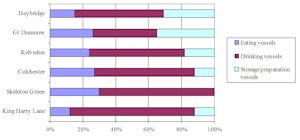
The Heybridge cremation burial assemblage is closest to Great Dunmow in functional character (Figure 742). In both, drinking vessels predominate, but vessels pertaining to other functions form a strong presence. The Colchester data, based on ninety burial groups from the Joslin Collection (May 1930), show an even greater preponderance of drinking forms at the expense of storage/preparation vessels, a trend repeated at Kelvedon and Skeleton Green. The proportion of eating vessels remains reasonably consistent at all sites, except at King Harry Lane, Verulamium.
Some caution must be noted, since assemblages vary chronologically and in size. Great Dunmow (Wickenden 1988), Skeleton Green (Partridge 1981) and Colchester yielded substantially larger assemblages than Heybridge, with 54, 105 and 260-plus vessels, respectively. King Harry Lane (Stead and Rigby 1989) provided seventeen vessels from sixteen Roman burials. The Kelvedon burials suffered from plough damage and robbing, and just ten cremation burials, yielding seventeen ancillary vessels, survived intact. Given assemblages of similar date and size, differences might become less pronounced. It should be noted, too, that Figure 742 shows differences in the types of vessels, not the perceived function of those vessels within the burials. Dishes used as lids, for example, have been placed in the eating vessel category, when actually they might have been more appropriately placed in the storage/preparation category. All cups have been placed in the drinking vessel category, but some, such as samian f27, were probably eating vessels (see Samian use-wear). These objections notwithstanding, differences seem clear enough, although the reasons for such differences are less so. A wider and more cohesive data set than is presented here is required before any strong connections between ceramic character, chronology, settlement status or geographic region can be made. It is worth suggesting, however, that local variations in funerary practice might well play some role. At Skeleton Green and King Harry Lane, in Hertfordshire, jars found in burial contexts serve almost exclusively as cinerary containers, while in the more easterly sites presented here, jars also appear as ancillary vessels.
Two samian vessels, an f33 cup from burial 12203 and an f18/31 dish from 12219, are probable 'seconds'. Both have distorted rims and show no signs of wear. The deposition of unused 'seconds' in burials was a common practice in Roman Britain and beyond (cf. Lyne 1999, 301; Tuffreau-Libre 2000, 54). Seconds, accidental products of firing, should not be confused with deliberately 'killed' vessels. Their inclusion in burials may be viewed as a sign of low status or poverty on the part of the mourners or the deceased. More realistically, seconds suggest the existence of a funerary market to which potters could sell their sub-standard products, though probably not directly. This implies that seconds, at least, were not collected from the household of the deceased or mourners, but instead bought as and when required for funerary purposes. We may imagine the involvement of burial societies, which ensured proper burial of its members (Lewis and Reinhold 1990, 185). Such societies may well have contributed grave-goods as well as financial grants, perhaps using their members' regular subscriptions to acquire stock.
Given the limited size of the burial assemblage overall, vessel treatment cannot be discerned in all burials. However, aspects of certain Area R burial groups are worth consideration. Vessels in three burial pits were specifically placed. In burial 12006, the cinerary vessel was placed on top of the samian f33 cup. The cinerary vessel in 12105 contained an inverted jar in addition to the bone. Burial 12203 was the most complex burial in terms of deliberate treatment. A beaker rested fully on top of a samian dish, while a samian cup partially rested on the same dish. No doubt, the vessels within this burial were also placed in relation to the non-ceramic grave goods, such as the hanging lamp. Placements similar to these are attested at other burial sites. At Great Dunmow, the cinerary vessel from Cremation 4 contained a flagon as well as the cremated bone. Additionally, a samian bowl was placed on its side, resting against the cremation vessel (Wickenden 1988, 15). Occasional vessels from the cemetery at Kelvedon were inverted (Rodwell 1988, 47).
These were all deliberate acts and the deceased and mourners were undoubtedly fully conversant with their symbolism. While we may remove the pots themselves from the ground, it is almost impossible to retrieve their meanings, and the motives behind the rituals must stay within the realms of speculation. One aspect that may be worth stressing is the physical contact between vessels, which may have aided the spiritual consumption of the items within them. The deceased could not actually hold the cup placed in burial 12006, but the physical link between that vessel and the cinerary container enabled the spirit to take the contents. If the jar placed inside the cinerary vessel in 12105 contained food, then the physical relationship between the two vessels enabled to the spirit to eat. The physically linked beaker, dish and cup in burial 12203 are harder to explain, since there is no contact with the cinerary vessel. We may suppose that vessel placement was not necessarily determined by a single motivation, or that the ancillary vessel contents (if any) were not limited to items directly related to the welfare of the soul.
In some cases, the motive behind vessel placements seems clear. Samian dishes were placed over the mouth of the cinerary jars in burials 12003 and 12219 (the dish in 12003 was inverted). Cremation 2 at the Langford Road site included a samian dish that covered the mouth of the cinerary vessel (Langton and Holbrook 1997, 26). Similar practices are widely attested at other sites, for example Colchester and Skeleton Green. Typically, shallow vessels were chosen to cover the cinerary container, as is the case for the two examples at Heybridge. The choice and use of a vessel may have been for entirely practical reasons; a shallow vessel is wide enough to cover the mouth but limits the final height of the deposit. Indeed, mundane motives may have determined the practice in the first instance, with the covering vessel acting as a lid to prevent soil contamination of the human remains. If this was the reason, then it did not overly concern the inhabitants of Heybridge (or Roman Britain, for that matter), as evidence for ceramic lids is relatively rare. Although organic bungs and covers could have been used instead of ceramic lids, the occasional use of flagons or beakers instead of shallow vessels (e.g. May 1930, pl. XCI, no. 3) suggests that conceptual motivations would better fit the evidence. The need to protect the human remains may well have been a factor, but this protection may have been as much spiritual as physical. Whatever the reasons behind this practice, it is suggested that the placement of vessels over the mouth of the cinerary vessel, and especially those that have been inverted, represents changes in original everyday function. An inverted dish is no longer able to bear food and so cannot be regarded as a food vessel, or as a container for offerings (Biddulph 2002, 104).
Two vessels, the dish that covered the cinerary vessel and a flask, both from burial 12219, were deliberately 'killed', with chips having been removed along the rim. Going (1988, 23) suggests that the type of vessel determined the type of mutilation. Thin-walled, narrow-mouthed vessels (e.g. flagons and jars) tended to be perforated, while rim segments were removed by saw from thicker-walled open forms, such as platters and dishes. As the 'killed' flask in 12219 demonstrates, this was not a hard and fast rule. Practically, knocking holes through the base or the sides risked smashing the pot, and drilling tended to be the favoured method for creating holes). The evidence for deliberately mutilated pottery is relatively infrequent, but widespread. Some of the commoner types of mutilation were identified at Great Dunmow and include removed rim sections and holes through bases and vessel walls (Going 1988, 22). At Kelvedon, some flagons were perforated or were chipped at the rim; jars had been perforated through the base (Rodwell 1988, 117-21). Within the wider region, the practice is also attested at, among others, Colchester (May 1930, pl. LXXVII, no. 16), Skeleton Green (Partridge 1981, fig. 102) and Folly Lane, Verulamium (Lyne 1999, 301). The practice is poorly understood and no single explanation seems to cover the full range of evidence. Suggestions include the notion that the missing fragments were retained by the living as keepsakes (Going 1988, 22). Alternatively, a vessel was mutilated so that it could not have been used against the living (Lyne 1999, 301). A variation of this explanation requires that pots were damaged so that they could pass from the realm of the living to that of the dead (cf. Down and Rule 1971, 73). None is a fully satisfactory explanation. The infrequency of the practice would seem to rule them out. At least two of the above explanations would be stronger if the same treatment within the burial pit was applied consistently to every vessel. Even within a single burial, each vessel might have been accorded different treatment, so that just one of a number of vessels might be 'killed'.
By focusing on the burial pit itself, we inevitably reduce the significance of its contents in any pre-burial funerary rite. However, in such rites, certain vessels ultimately included in the burial pit may have served specific functions. Some of these functions may have left tell-tale signs on pots or required the vessels to be placed inside the pit in certain ways. What we recover, then, may be an end-product, rather than primary evidence of preparation for the journey from one world to the next. Effectively, the significance of those vessels may have ended with their final burial.
A pre-burial funerary rite that perhaps might best fit the phenomenon of 'killing' alludes to sacrifice. Creighton (2000, 204) suggests that the paraphernalia of sacrifice - bowls, paterae and ladles, usually in metal - were represented in the aristocratic graves of the Late Iron Age. So, the mutilated food vessels stood proxy for animals; indeed, they may have actually contained the meat of those animals. Alternatively, eating vessels contained food 'sacrificed' through the killing of the vessels, or salted flour (mola salsa), traditionally sprinkled over the victim. Mutilated liquid containers contained wine for pouring over the 'victim', or liquids for sacrificial libations. Creighton (2000, 204) adds that sacrifice was the business of the aristocracy. The infrequent appearance of 'killed' vessels is consistent with a minority practice. But while the extent of the practice is unclear, it is certain that sacrifice could form part of the funerary process. Virgil's description of Aeneas conducting the funeral of his fallen comrade Misenus includes the burning of sacrificial food on the pyre (6, 235). Epigraphic evidence from other parts of the Empire suggests that sacrifices were undertaken at burial places on special days and anniversaries to commemorate the dead (cf. Lewis and Reinhold 1990, 524).
Despite the limited data set, this study has revealed a varied pattern of burial practices at Heybridge during the Roman period. The burial data are broadly typical of Roman burial practices across the region. However, this study has indicated differences between non-burial domestic assemblages and burial assemblages at Heybridge, suggesting that ceramic vessels placed inside the burial pit were selected. In addition, analysis of assemblage composition has proved a useful tool for comparing the burial data to a range of settlements, highlighting differences between them. Potentially, these differences could help to characterise settlement types, and more data from more sites are required. However, that Heybridge seems to be closer to 'lower-order' settlements, in terms of composition, than settlements with greater urban development accords well with the evidence of settlement morphology, economy and artefactual supply.
It is apparent that there are more similarities between Late Iron Age and Roman cremation ceremonies than differences. These similarities lie in the use of a cinerary urn to contain the cremated remains for burial, noted in at least fifteen of the twenty-two recorded burials, and in the presence of one or more ancillary vessels. It is here that differences may perhaps be discerned. The Roman-period burials display more variety in the types of ancillary vessels provided, with flasks, small beakers and samian cups and dishes more frequently deposited. This may reflect the increasing availability of these vessel types during the Early Roman period, coupled with a continuing desire to furnish graves with out-of-the-ordinary ceramics.
That there are more similarities than differences is unsurprising, since the rite of cremation, as seen in Heybridge, has its roots in Gaulish customs that were evidently introduced before the conquest. That the take-up of cremation, as a method of disposing of the dead, may have been a gradual process is indicated by the low number of recorded formal burials of Late Iron Age date. It should be noted, however, that no other methods for disposal of the dead were archaeologically recognised until the probable inhumations of the Late Roman period. It is also true that the Roman-period cremation burials are also relatively few in number. It is difficult to draw firm conclusions from such a low number of burials, although the trends identified are likely to be substantiated by comparison with burial assemblages of either period recorded elsewhere in the region.
Internet Archaeology is an open access journal based in the Department of Archaeology, University of York. Except where otherwise noted, content from this work may be used under the terms of the Creative Commons Attribution 3.0 (CC BY) Unported licence, which permits unrestricted use, distribution, and reproduction in any medium, provided that attribution to the author(s), the title of the work, the Internet Archaeology journal and the relevant URL/DOI are given.
Terms and Conditions | Legal Statements | Privacy Policy | Cookies Policy | Citing Internet Archaeology
Internet Archaeology content is preserved for the long term with the Archaeology Data Service. Help sustain and support open access publication by donating to our Open Access Archaeology Fund.